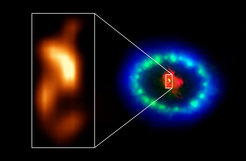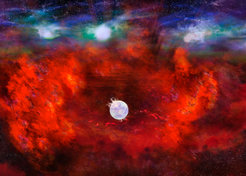ALMA finds possible sign of neutron star in Supernova 1987A
Two teams of astronomers have made a compelling case in the 33-year-old mystery surrounding Supernova 1987A. Based on observations with ALMA and a theoretical follow-up study, the scientists provide new insight for the argument that a neutron star is hiding deep inside the remains of the exploded star. This would be the youngest neutron star in our cosmic neighbourhood known to date.
Ever since astronomers witnessed one of the brightest explosions of a star in the night sky, creating Supernova 1987A (SN 1987A), they have been searching for a compact object that should have formed in the leftovers from the blast. Because particles known as neutrinos were detected on Earth on the day of the explosion (23 February 1987), astronomers expected that a neutron star had formed in the collapsed centre of the star. But when scientists could not find any evidence for that star, they started to wonder whether it subsequently collapsed into a black hole instead. For decades, the scientific community has been eagerly awaiting a signal from this object that has been hiding behind a very thick cloud of dust.

Extremely high-resolution ALMA images revealed a hot “blob” in the dusty core of Supernova 1987A (inset), which could be the location of the missing neutron star. The red colour shows dust and cold gas in the centre of the supernova remnant, taken at radio wavelengths with ALMA. The green and blue hues reveal where the expanding shock wave from the exploded star is colliding with a ring of material around the supernova. The green represents the glow of visible light, captured by NASA's Hubble Space Telescope. The blue colour reveals the hottest gas and is based on data from NASA's Chandra X-ray Observatory. The ring was initially made to glow by the flash of light from the original explosion. Over subsequent years, the ring material has brightened considerably as the explosion's shock wave slams into it.
Recently, observations from the ALMA radio telescope provided the first indication of the missing neutron star. Extremely high-resolution images revealed a hot “blob” in the dusty core of SN 1987A, which is brighter than its surroundings and matches the suspected location of the neutron star.
“We were very surprised to see this warm blob made by a thick cloud of dust in the supernova remnant,” said Mikako Matsuura from Cardiff University and a member of the team that found the blob with ALMA. “There has to be something in the cloud that has heated up the dust and which makes it shine. That’s why we suggested that there is a neutron star hiding inside the dust cloud.”
Even though Matsuura and her team were excited about this result, they wondered about the brightness of the blob. “We thought that the neutron star might be too bright to exist, but then Dany Page and his team published a study that indicated that the neutron star can indeed be this bright because it is so very young,” said Matsuura.
Dany Page is an astrophysicist at the National Autonomous University of Mexico, who has been studying SN 1987A from the start. The theoretical study by Page and his team, published today in The Astrophysical Journal, strongly supports the suggestion made by the ALMA team that a neutron star is powering the dust blob. “In spite of the supreme complexity of a supernova explosion and the extreme conditions reigning in the interior of a neutron star, the detection of a warm blob of dust is a confirmation of several predictions,” Page explained.

This artist's illustration of Supernova 1987A shows the dusty inner regions of the exploded star's remnants (red), in which a neutron star might be hiding. This inner region is contrasted with the outer shell (blue), where the energy from the supernova is colliding (green) with the envelope of gas ejected from the star prior to its powerful detonation.
These predictions were the location and the temperature of the neutron star. According to supernova computer models, the explosion has “kicked away” the neutron star from its birthplace with a speed of hundreds of kilometres per second (tens of times faster than the fastest rocket). The blob is exactly at the place where astronomers think the neutron star would be today. And the temperature of the neutron star, which was predicted to be around 5 million degrees Celsius, provides enough energy to explain the brightness of the blob.
“The bulk of iron produced in SN 1987A is expected to be ejected opposite to the direction of the neutron star kick,” explains team member Hans-Thomas Janka of the Max Planck Institute for Astrophysics. “Comparing the observed iron distribution with 3D computer models we predicted the neutron star to be located north of the explosion centre, in agreement with the location where the hot blob was later detected.”
Such a neutron star is a 25 km wide, extremely hot ball of ultra-dense matter. A teaspoon of its material would weigh more than all the buildings within New York City combined. Because it can only be 33 years old, it would be the youngest neutron star ever found in our Milky Way Galaxy and its close cosmic neighbourhood. The second youngest neutron star that we know of is located in the supernova remnant Cassiopeia A at a distance of 11,000 light years and is 330 years old. The neutron star in SN 1987A is 15 times farther away in the Large Magellanic Cloud, a small satellite galaxy of the Milky Way.
Only a direct picture of the neutron star would give definite proof that it exists, but for that astronomers may need to wait a few more decades until the dust and gas in the supernova remnant become more transparent.













